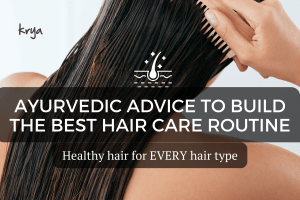This post was last updated on May 27, 2022 by srinivas krishnaswamy
We spoke last week about a common hair fall issue that we are seeing increasingly at Krya – hair loss that is traced to the post delivery period in women, or post partum hair loss. We spoke yesterday about how modern methods of treating pregnancy and child birth are at odds with what Ayurveda. These differences can lead to the severe dosha imbalance we see today and the many distressing extreme problems of hairfall that come our way.

At Krya, it is a part of our mission to communicate just how advanced, well thought out and deeply rooted the science of Ayurveda is. Apart from what we post about, here is a gem I came across in my reading today.
Manasa Vikasam – Psychological development of the infant
An individual comprises of 24 tattvas (principles / realities) which comprise of the learnings their soul carries, their genetic makeup, their “aham” ego, their manas (mind), etc. The sum of these individual tattvas for each individual is called the “mahat”. As the Mahat begins to interact with environment, Ayurveda believes that psychic and psychological development begins. Unexplained talents and gifts that evolve in children are believed by Ayurveda to be gifts or talents developed in the previous cycle of birth.
The Ahamcara (loosely described as the I / Ego) is a set of unorganised drives, feeling and emotions which lies dormant within the Mahat. Depending upon the experiences that occur to the individual, both good and bad, the Ahamcara develops in later life, influenced by the positives and negatives surrounding the child.
Depending upon the experiences of the child, the Ahamcara may develop into a sattvic personality, a rajasic personality or a tamasic personality.
Herein lies the Ayurvedic genius of surrounding the foetus with good experiences and fulfilment at the antenatal stage. The pregnant woman is referred to in Ayurveda as the Dauhridini (the woman with 2 hearts). Her unexplained food preferences or wishes in the pregnancy are said to arise from the foetus who expresses his / her wishes through the mother. Ayurveda opines that as far as possible, the wishes of the Dauhridini should be fulfilled. Even in the case where her wishes are harmful to her and the foetus, she is to be treated in a loving manner and should be sweet talked or cajoled into accepting another similar fulfilment which does not harm her or the baby.

Surrounding the foetus and her growing Ahamcara with positivity, love and fulfilment of her desires even at the foetal stage, helps develop her Ahamcara and mahat well and makes for better Manasa Vikasam in the later stage. Unfulfilled wishes of the foetus is said to lead to cognitive disorders in the pre birth stage or psychological disorders as the child grows to be an adult.
Increase in vata dosha post childbirth – leading cause of post partum hair fall
Our post yesterday discussed how Ayurveda views the process of childbirth and the after effects on vata dosha. We spoke about how Ayurveda traditional practices of internal oleation, controlling the diet of the pregnant women and the use of post natal abhyangas, tying of the stomach and inclusion of ghee (both as a diet supplement and in its medicated form) help control the excess vata post child birth.

As the baby is born, there is a gap in the womb which vayu (air) attempts to occupy. If this space is not controlled and enough Sneha (fat) is not given internally to control the entry of vayu, the excess vata dosha can manifest as hair and skin disorders which can later lead to greater vata based disorders.
This then explains the common complaint of post partum hair fall. When excess vata is left unchecked and no measures of controlling vata are adopted, it dries up the body internally causing dry and brittle and weak hair, and aches and pains in the joints, a lack of enthusiasm and energy and an overall feeling of tiredness and exhaustion.

We had mentioned how external oleation and hair oiling is a cornerstone in controlling this excess vata for post partum hair fall.
Excess vata – an urban malaise
Cities are considered high in vata dosha. By the nature of their design, the long distance commutes, high cell phone and device usage, and the nature of modern office jobs, all of us quickly accumulate excess vata dosha.

By our frequent commutes, plane travel, excessive use of mobile phones, late nights, eating out and varying timings of eating, the vata dosha tends to aggravate. This leads to urban malaise disorders like lower back, joint aches, neck and shoulder aches, an inability to fall asleep easily, and a feeling of tiredness and a need for stimulants like coffee and tea to get us through our days.
When this existing urban malaise is combined with a serious vata affecting condition like what is seen after pregnancy, we see the vata disorders magnified by a massive amount leading to sudden, excessive and seemingly uncontrollable hair fall.
Ayurvedic herbs to control excess vata
Sneha (fats) are the key to controlling vata. Fats are thick, oily, unctuous, and smooth and are the opposite of vata dosha which is rough, dry, coarse and brittle. Most Sneha or fats are also kapha promoting because of their thick and unctuous nature. So when Ayurvedic oil is made for the purpose of balancing excess vata dosha, it is important to use a judicious base of oils and carefully chosen Ayurvedic herbs to ensure other doshas are kept in check.

The Ayurvedic texts mention a good selection of herbs to help control vata. The texts also advise using carminative, slightly pitta increasing spices to help control vata for an important reason. The warming action of these herbs helps control the cold nature of vata and also decreases the kapha building property of the Sneha. In the next section, we will see a sample of vata reducing herbs that are used in the Krya Abhyanga oil.
The Krya Abhyanga skin oil with Vacha and Ashwagandha
Bala (Sida cordifolia)
Ayurvedic texts classify the herb Bala as a group of 4 herbs – “balachatustaya”. Bala is considered “brmhaniya” – promotes healthy muscle growth, “balya” – tonic and “vata samsamana” – pacifies vata dosha.
Acharya Charaka mentions that Bala is a rasayana drug (rejuvenative) for muscle tissue and muscular system. The literal translation of the Sanskrit word “Bala” is “strength” –so all the 4 Bala herbs are a tonic for the body and a rejuvenative when used in vata disorders.
As Bala is sweet in its rasa, it also helps alleviate excess pitta. It is therefore also considered valuable blood purifier helpful in rakta pitta disorders.

Two Krya massage oils use Bala – the Krya traditional baby massage oil uses Bala to impart strength and aid healthy muscle development for babies. The Krya Abhyanga oil uses Bala to relieve excess vata, balance excess pitta and to bring relief in vata based complaints like post partum hair fall, joint aches, and other complaints associated with vata vitiation.
Ashwagandha (Withania somnifera)
Ashwagandha is a famous Ayurvedic herb known for its rasayana and kapha and vata balancing properties. The term Ashwagandha comes from the Sanskrit words “ashwa” meaning horse and “gandha” meaning odour – Ashwagandha as the texts describe is the herb that smells like a horse.
Just like the horse, the Ashwagandha herb imparts strength, speed and virility when used. Apart from these properties, it balances kapha and vata dosha, nourishes all dhatus (tissues) and has a rasayana effect on the entire body.

Apart from these properties, Ashwagandha has a marked anti-arthritic effect and is very useful in inflammatory conditions like gout. It is also a calming herb and helps relax frazzled nerves and is a very strong rejuvenative herb to all the muscle tissues.
We use Ashwagandha in all our skin oils for adults at Krya. It goes into the Krya Abhyanga skin oil for its vata and kapha alleviating properties and its strong action to relieve muscle pain and inflammatory conditions.
Ashwagandha also goes into the Krya Moisture plus skin oil for its excellent skin regenerative and rasayana properties. This oil is meant as a frequent pre-bath moisturising product that we recommend for extremely dry skin and for very cold climates. Ashwagandha is also used in small doses in the Krya Classic Skin oil which is designed for the moisturizing needs of normal – oily skin and is to be used pre-bath as well.
Maricha (Piper nigrum) / Pepper / Kali Mirch / Milagu
Maricha is the Sanskrit name for black pepper which is one of the names of the Sun, referring to the hot and potent properties of black pepper. The use of black pepper is well documented in Indian cuisine for its ushna (heat), kola – taste improving sensation, Teekshana – sharp and intense flavour, krimihara – destroys insects and worms, etc.
Maricha is a spice that is revered in Indian medicine and was held n high esteem by the Ayurvedic Acharyas. Acharya Charaka classifies Maricha as a dipaniya (appetiser), sulaghna (relieves colic) and krimighna (removes intestinal worms). It is also classified as a rasayana drug for the respiratory system. Maricha is one of the 3 herbs used in “Trikatu” – three pungent spices which are used in severe colds, respiratory illnesses, and in reducing kapha accumulation.

As Maricha is hot and virya (strong) and carminative (wind expelling), we add it in small quantities as kashayas to the Krya abhyanga skin oil and the Krya traditional baby massage oil. This helps increase the warmth of both oils improving their vata reducing properties, helps the penetration of the oil better and also prevents kapha related side effects like coughs and colds.

These 3 herbs are a sample of the 16 dosha balancing, skin improving and health giving herbs and the 3 cold pressed , organic base oils we use in the Krya Abhyanga oil. As mentioned before we use the Tila paka method while making all of Krya’s oils.
The Ayurvedic Tila paka method – a sophisticated ancient oil manufacturing technique
The Tila paka method is one of the sophisticated oil manufacturing methods used by Ayurveda to make herb infused oils. Another method of making Ayurvedic oils is the Aditya paka method, where herbs are left to infuse in oil that is placed in the Aditya (Sun). This method is less popular compared to the Tila paka method, as there is a greater limitation on the use of watery herbs compared to the Tila paka method.
The Tila paka method helps transfer the properties of several carefully chosen herbs into base oil or a combination of base oils. Depending upon the properties of each herbs and whether they express their actives best in an oil phase or water phase, the herbs are either extracted through water or added as a paste into oil.
Ayurveda uses a combination of methods even in water extraction depending upon the woodiness, aroma and delicacy of the herb. Flowers are usually extracted as cold infusions or lukewarm teas to protect their delicate flavenoids. Thick hard, woody herbs are extracted in water separately using strong kashayams. Soft leaves are extracted as milder boiled infusions called kwathas.

Oil based herbs and seeds are usually directly added to the oil to allow the oil based actives to percolate into the base oils. These form a part of the kalpa (herb pastes) that are added to Ayurvedic oils.
The result of this is a very deeply herb infused base oil which has used the correct medium to extract the actives from each set of herbs.
The Tila paka process is transformative in nature. The base oils we use like sesame oil, coconut oil, kokum butter etc completely transform in their stickiness, penetrative ability, colour and fragrance – the oil becomes something entirely new. The interesting change is also in how the base oils transform. Many of us may find sesame a thick, slightly difficult to use oil, for example. But we have seen time and gain, how the Tila paka process transforms the sesame oil to an oil that penetrates skin and hair very quickly, with a completely different fragrance from its original fragrance.
Krya products recommended to balance vata for women and men:
Depending on your hair type, we will also in addition suggest the right Krya hair system for you – Classic, Conditioning, Anti Dandruff or Damage Repair.
To conclude:
We have been speaking about the transformative effects of simple practices mentioned in the Ayurvedic Dinacharya (daily regime) on our health. The disorders caused by dosha imbalances can seem awful and daunting, but often the answer to helping your body lies in seemingly simple, yet deep transformative daily changes.
Can we give you a guarantee that our hair oil alone can help your post partum hair loss? No, and no one should give you one. As we have explained, any external disorder that manifests is a sign of a deep internal lack of balance, and a programme designed to correct this internal imbalance through diet, regimen changes and external application has the greatest chance of succeeding.
We hope you enjoyed reading this post and also hope you were able to appreciate the difference in approach Krya followed when treating hair and skin problems. If you too are experiencing hair and skin disorders, and would like to consult us, do call us on 075500-89090 or write to us.
Remember, beauty is achieved only when health is achieved.





